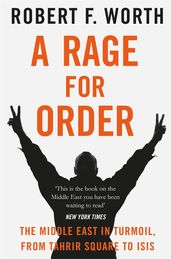Synopsis
In 2011, a wave of revolution spread through the Middle East as protesters demanded an end to tyranny, corruption and economic decay. From Egypt to Yemen, a generation of young Arabs insisted on a new ethos of common citizenship. Their bravery and idealism stirred observers around the world and led militant jihadists to worry that they had been superseded by a new and peaceful uprising.
Five years later, the utopian aspirations of 2011 have darkened. In one country after another, brutal terrorists and dictators have risen to the top as old divides reemerge and deepen. Egypt has become a more repressive police state than ever before; Libya, Syria and Yemen endure civil war and the extremists of ISIS have spread chaos and carnage across the region, and beyond it.
A Rage for Order tracks the tormented legacy of what was once called the Arab Spring. Writing with bold literary ambition, the distinguished New York Times correspondent Robert F. Worth introduces a riveting cast of characters. We meet a Libyan rebel who must decide whether to kill the torturer who murdered his brother; a Yemeni farmer who lives in servitude to a poetry-writing, dungeon-operating chieftain; two young Syrian women whose close friendship devolves into enmity as their sects go to war; and an Egyptian doctor who is caught between his loyalty to the Muslim Brotherhood and his hopes for a new, tolerant democracy. In a final chapter, Worth tells the moving story of the two eighty-something statesmen whose unlikely camaraderie allowed Tunisia to escape its neighbours' worst fates.
Combining dramatic storytelling with an original analysis of the Arab world today, A Rage for Order captures the psychological and actual civil wars raging throughout the Middle East and explains how the dream of an Arab renaissance gave way to a new age of discord.
Details
Reviews
This is the book on the Middle East you have been waiting to read. [It] tells the story of the 2011 Arab Spring and its slide into autocracy and civil war better than I could ever imagine its being told. The volume is remarkably slender for one of such drama and scope - beautifully written . . . All great works of fiction are works of great philosophy, pondering the fundamentals of humanity. Few volumes of non-fiction ever achieve this, but Worth's does, touching essential human truths about the human condition . . . The writing is so beautiful and the storytelling so easy that you won't realize how much you are learning as you read. But there is no escaping the import of the stories. No way to read this marvellous book and not understand far more than you did before about this troubled region and the people struggling to find their way back to quiet lives
Riveting, vivid, lucid, and wise, Robert F. Worth's A Rage for Order is reportage of the highest order: it illuminates current Middle Eastern crises through the daily experiences of ordinary, and extraordinary, men and women. I've read no finer or more nuanced account.
The best way to make sense of the past six years is to ask the Arab people what happened . . . Robert Worth has done just that . . . Worth narrows the field of view, using personal narratives to illuminate the larger dynamics. This is a common technique, but Mr Worth does it better than most.
It would be hard to find a more astute and eloquent guide to this explosive corner of the Earth than Robert F. Worth. He somehow managed to be on hand for a score of crucial moments in the Arab world's great convulsions, from the vast demonstrations of Tahrir Square to a just-liberated Libyan prison to the crushing of great hopes in the years that followed. Whatever lies ahead, I suspect that, as with John Reed's reporting on the Russian Revolution, people will be reading this vivid eyewitness account for years to come.
